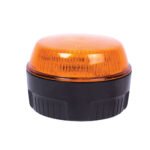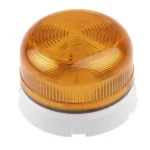In emergency situations, the ability to quickly and effectively communicate critical information can mean the difference between life and death. That’s where the Red Xenon Beacon comes in. This powerful signaling device is designed to provide a bright and highly visible indication of emergency situations, making it an invaluable tool for a wide range of applications. In this article, we’ll take a closer look at the Red Xenon Beacon, how it works, and why it’s such a critical tool in emergency response.
What is a Red Xenon Beacon?
A Red Xenon Beacon is a powerful signaling device that emits a bright red flash of light. This flash is produced by ionizing the gas within a glass tube filled with xenon gas. The resulting flash is intense and highly visible, making it an ideal solution for emergency signaling.
The beacon is typically mounted on a pole or other high location, making it visible from a distance. The flash is usually triggered by an electrical signal, and the device can be programmed to emit a specific pattern of flashes to convey specific information.
Red Xenon Beacons are commonly used in a variety of emergency situations, including industrial accidents, natural disasters, and other critical events where rapid and effective communication is essential.
How Does a Red Xenon Beacon Work?
As mentioned, a Red Xenon Beacon works by ionizing the gas within a glass tube filled with xenon gas. When an electrical charge is applied to the tube, the gas becomes ionized, producing a bright flash of light.
The process of ionizing the gas in the tube is known as the “flashover” process. During this process, the voltage applied to the tube causes the gas to ionize, which in turn produces a flash of light. The duration and intensity of the flash can be controlled by adjusting the voltage and other parameters of the electrical signal.
Red Xenon Beacons can be powered by a variety of sources, including batteries, solar panels, and external power sources. The device can also be programmed to emit specific patterns of flashes to convey different types of information, such as the severity of an emergency or the need for specific types of response.
Applications of Red Xenon Beacons
Red Xenon Beacons are commonly used in a variety of emergency situations, including industrial accidents, natural disasters, and other critical events where rapid and effective communication is essential. Some of the most common applications of Red Xenon Beacons include:
- Industrial Safety: Red Xenon Beacons are commonly used in industrial environments to signal an emergency, such as a chemical spill or explosion. The bright flash of light can alert workers to evacuate the area quickly and safely, potentially saving lives.
- Traffic Safety: Red Xenon Beacons are often used in traffic control applications to signal an accident or other emergency on the road. This can help prevent further accidents and ensure that emergency responders are able to reach the scene quickly and safely.
- Marine Safety: Red Xenon Beacons are also commonly used in marine environments to signal an emergency, such as a distress call or collision. The bright flash of light can help other vessels and rescue crews locate the distressed vessel quickly, potentially saving lives.
- Aviation Safety: Red Xenon Beacons are also commonly used in aviation applications to signal an emergency, such as a crash or fire. The bright flash of light can help rescue crews locate the crash site quickly and safely, potentially saving lives.
Conclusion
In emergency situations, the ability to quickly and effectively communicate critical information is essential. The Red Xenon Beacon is a powerful signaling device that can provide a bright and highly visible indication of emergency situations, making it an invaluable tool for a wide range of applications. Whether you’re working in an industrial environment, on the road, or at sea,



